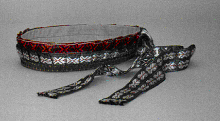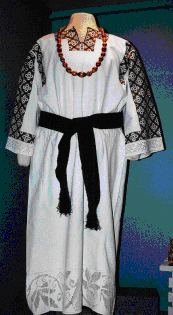
From 1884-1914 the population of Hungary dropped by more than 2,500,000 as millions of people moved to North America because of the poor social conditions which left most Hungarians in the countryside with no land. Many of these people came with the hope of making enough money to go back to Hungary and buy land - a hope that would not be realized for most of them. Some of these Hungarian immigrants came to Lethbridge in the 1880's and 1890's. Most of the first Hungarians to arrive in Lethbridge worked in the coal mines in the area. A few of them began to farm near Milk River and Taber in the first decade of the 20th century.

P19890026002-GA Handmade headband that is often worn by many traditional dancers.
The Hungarian and, indeed, all the Central European miners were often disliked by the rest of the community. Some of the negative stereotypes that existed concerning Hungarians are evident in the comments of the superintendent of the North West Mounted Police. In 1892 he wrote that “the Hungarian and Slavish miners are quarrelsome people and do not get on with each other at all well. They have a nasty habit of bringing long-bladed knives into play.” The distrust with which many viewed Hungarians increased with the start of World War I. Hungarians were viewed as possible enemies, and they were either registered or interned by the government. Hungarians in Lethbridge responded by distancing themselves from the Austrian empire and demonstrating their loyalty to Canada. Still, suspicions and prejudice remained. After the war, Hungary was almost destroyed which led to a change in the thinking of many Hungarian miners. From this time on, Lethbridge was no longer a place to work for a few years; it was a permanent home.
The end of World War I also brought a new wave of Hungarian immigrants to the Lethbridge area during the 1920's. Most of these immigrants worked in the sugar beet fields for many years, although many of them bought their own farms. Many of the Hungarians in southern Alberta who did not buy their own farms settled in the north side of Lethbridge. When the Depression came in the 1930's many of the Hungarian farm workers were hit quite hard. Some of them were involved in a beet workers’ strike in 1936. The Hungarian Mutual Benefit Federation, which worked mostly with coal miners, was also active during this period. It provided sick benefits and insurance, as well as political education for its members. As the existence of such an group shows, there was some sympathy for leftist political causes among the many Hungarians who were miners and agricultural workers.
In the first years after World War II there were over 800 people of Hungarian descent in Lethbridge. When a rebellion in Hungary was defeated in 1956 about 600 more Hungarians arrived in southern Alberta. But most of these immigrants did not stay in the area. They were mostly college-educated professionals, unprepared for working in the sugar beet fields. The majority of these immigrants moved on to larger cities where they looked for better opportunities.

P19770058100-GA Traditional dress from Eastern Europe.
Churches have been important social institutions for the Hungarian community in Lethbridge. The majority of Hungarians in Canada are Catholic, and in the 1920's the Roman Catholic church began to set up Catholic parishes among the Hungarians and other central Europeans who lived on the north side of the city. Most Hungarian Catholics attended St. Peter and St. Paul’s Church. Later, they were taken into Catholic parishes throughout the city. There are also a large number of Presbyterians among the Hungarians of Lethbridge. The first Hungarian Presbyterian service was held in 1926, and Bethlen Presbyterian Church still exists today. Finally, there is a Hungarian Old-Timers Club which has operated since 1929. This club helps to preserve the legacy of an ethnic group that has contributed greatly to the history of Lethbridge and southern Alberta.
Previous Page | Exhibit Contents | Home | Navigation Information | Glossary | Curriculum Guide | Next Page
Copyright © 1996 Sir Alexander Galt Museum. All rights reserved.